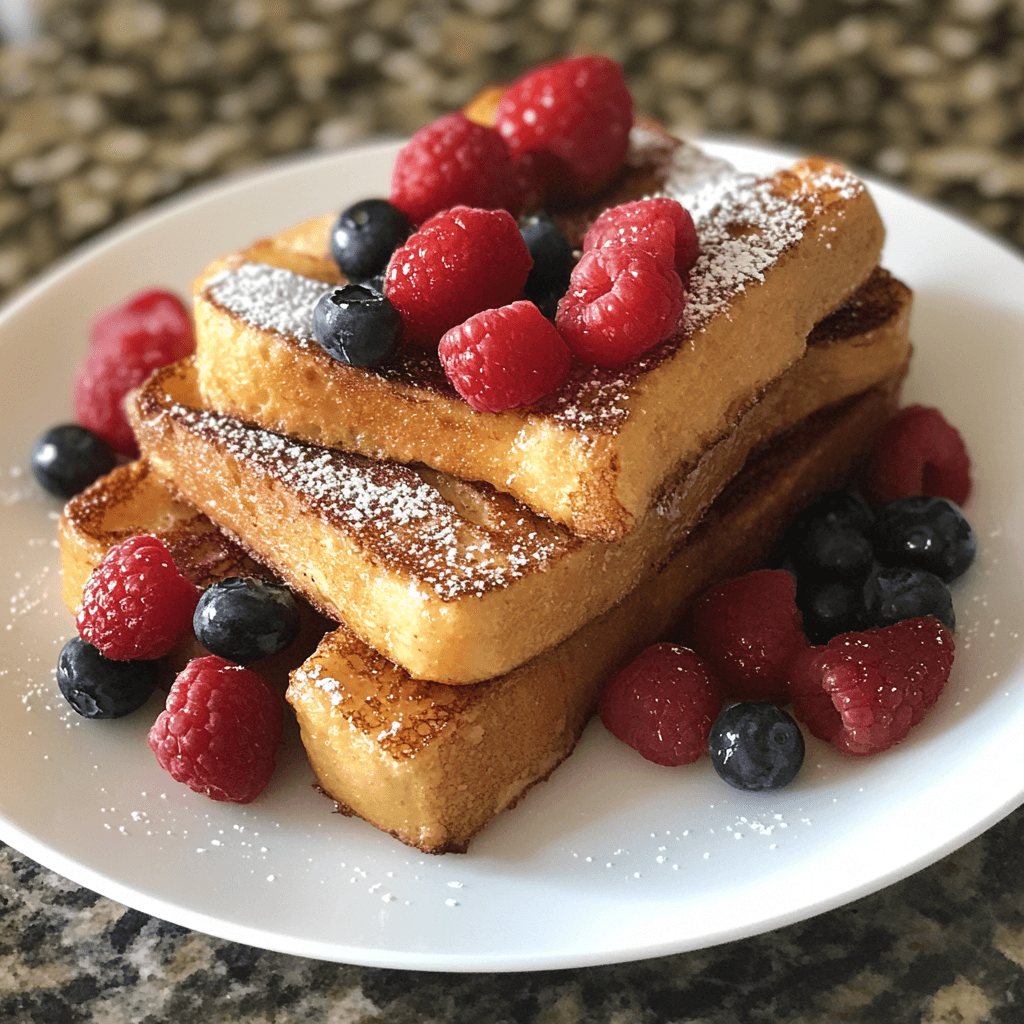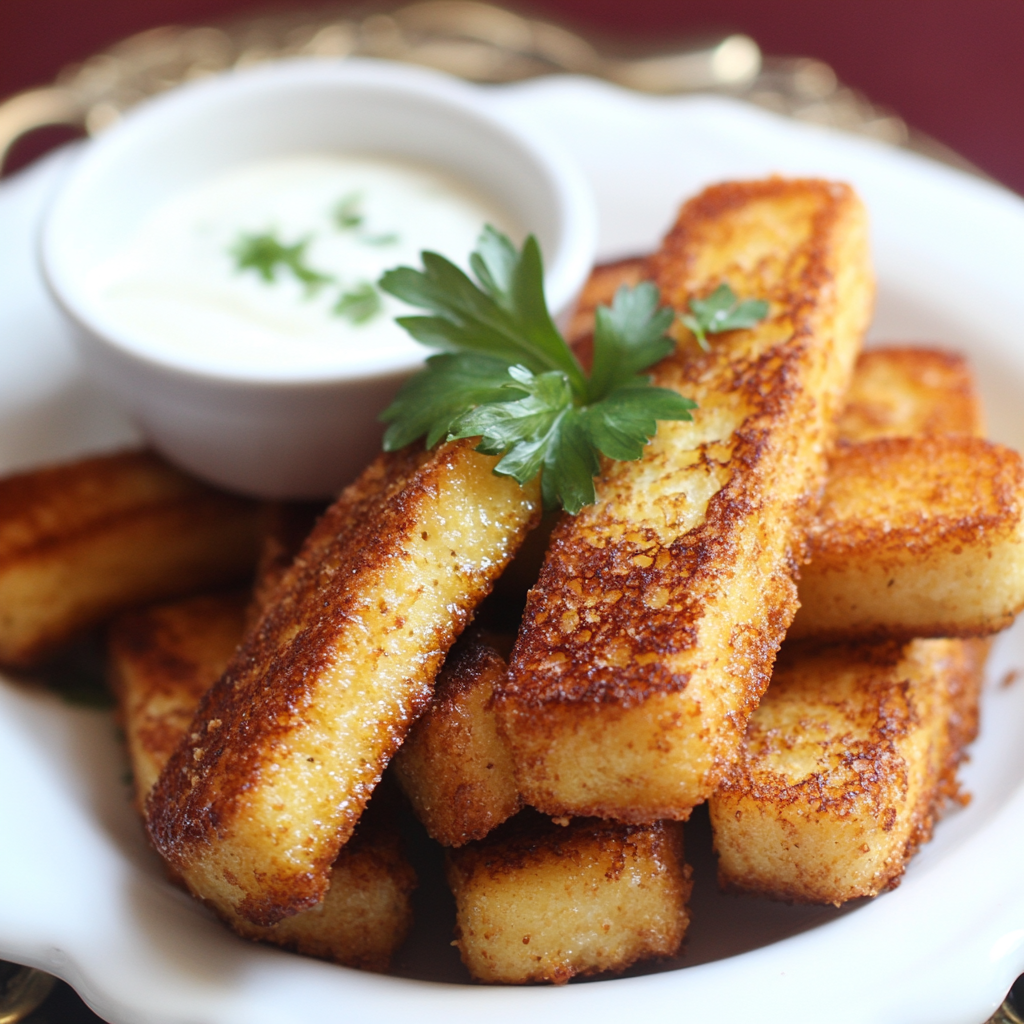Introduction to French Toast Sticks
What Are French Toast Sticks?
French toast sticks are a fun, bite-sized twist on classic French toast. Made by slicing bread into strips, dipping them into a rich egg custard mixture, and cooking them to golden-brown perfection, these sticks are easy to make and even easier to enjoy. Their finger-friendly size makes them ideal for dipping into maple syrup, honey, or other favorite sauces.
Why French Toast Sticks Are Perfect for Kids and Adults
French toast sticks are perfect for all ages because they combine taste, convenience, and fun:
- For Kids: Their small, manageable size makes them easy to eat and great for dipping, turning breakfast into a hands-on experience.
- For Adults: French toast sticks are a nostalgic yet indulgent option, perfect for a quick breakfast or a brunch spread. They’re also easy to prep ahead of time for busy mornings.
- On-the-Go: They can be enjoyed as a sit-down meal or a portable snack, making them versatile and family-friendly.
Origins and Evolution of French Toast
French toast, also known as “pain perdu” or “lost bread,” dates back to ancient times when cooks soaked stale bread in milk and eggs to make it edible and delicious again. Over the centuries, the dish evolved and became a breakfast favorite across the world. French toast sticks are a modern, playful adaptation, transforming the classic into a convenient and kid-friendly version that has become a staple in many households.
Ingredients for the Perfect French Toast Sticks Recipe
Essential Ingredients for Classic French Toast Sticks
To make irresistible French toast sticks, you’ll need:
- Bread: Thick slices of sturdy bread, like brioche, challah, or Texas toast.
- Eggs: Essential for creating the custard base.
- Milk: Whole milk or cream for a rich and creamy texture.
- Vanilla Extract: Adds warmth and depth to the custard.
- Cinnamon: Provides a cozy, spiced flavor that enhances the dish.
- Sugar: A small amount to lightly sweeten the custard.
- Butter: For cooking the sticks to golden perfection.
Best Bread Choices for French Toast Sticks
The key to great French toast sticks lies in choosing the right bread. The best options include:
- Brioche: Soft, buttery, and slightly sweet—perfect for indulgent French toast.
- Challah: A slightly dense and sturdy bread that holds up well when dipped.
- Texas Toast: Thick and fluffy, making it ideal for slicing into sticks.
- French Bread: Works well for a chewier, crispier result.
Ensure the bread is slightly stale or lightly toasted to help it absorb the custard without becoming soggy.
Optional Add-ins for Unique Flavor Enhancements
Take your French toast sticks to the next level with these optional flavor add-ins:
- Nutmeg: A pinch of nutmeg adds a warm, aromatic flavor.
- Orange Zest: Adds a fresh, citrusy twist to the custard mixture.
- Cocoa Powder: Mix in 1–2 teaspoons for a subtle chocolate flavor.
- Maple Syrup or Honey: Add a teaspoon to the custard for natural sweetness.
- Coconut Milk: Replace regular milk for a tropical twist.
With these ingredients and options, you can easily customize the recipe to suit any flavor preference, creating French toast sticks that everyone will love!
Equipment You Need to Make French Toast Sticks
Kitchen Tools for Ease: Skillet, Mixing Bowl, Whisk, and Spatula
To prepare French toast sticks with ease, you’ll need the following essential kitchen tools:
- Skillet or Griddle: A flat cooking surface for evenly frying the bread sticks.
- Mixing Bowl: For whisking the custard mixture. Choose a shallow bowl for easy dipping.
- Whisk: Ensures the eggs, milk, and spices combine smoothly without lumps.
- Spatula: A wide, flat spatula makes flipping the sticks easy without tearing them.
These basic tools make the process efficient and ensure consistent, delicious results.
Why a Non-Stick Pan Makes a Difference
A non-stick pan is the ideal choice for making French toast sticks because:
- It prevents the bread from sticking to the surface, allowing for an even, golden-brown crust.
- Less butter or oil is required, helping you achieve crisp results without an overly greasy texture.
- Cleanup is easier, as the custard won’t cling to the surface during cooking.
If you don’t have a non-stick pan, a well-seasoned cast-iron skillet is a great alternative for even heat distribution.
Step-by-Step Instructions for Making French Toast Sticks
Preparing the Bread into Sticks
- Choose thick slices of bread like brioche, challah, or Texas toast. Slightly stale bread works best to prevent sogginess.
- Use a sharp knife to slice each piece of bread into 3 or 4 even strips, about 1 inch wide. These strips will hold their shape and cook evenly.
Whisking the Custard Mixture
- In a shallow mixing bowl, whisk together the following ingredients:
- 2 large eggs
- ½ cup of whole milk (or cream for extra richness)
- 1 teaspoon ground cinnamon
- 1 teaspoon vanilla extract
- 1 tablespoon sugar (optional for added sweetness)
- A pinch of salt to enhance the flavors.
- Whisk until the mixture is smooth and the cinnamon is evenly distributed without clumps.
Dipping and Coating the Bread Sticks
- Quickly dip each bread stick into the custard mixture, ensuring all sides are coated.
- Let any excess custard drip off to avoid soggy or overly wet bread.
- Avoid over-soaking—3–5 seconds per stick is enough for the bread to absorb the custard without falling apart.
Cooking the French Toast Sticks to Perfection
- Heat a non-stick skillet or griddle over medium heat and add 1 tablespoon of butter. Let it melt and sizzle gently.
- Place the coated bread sticks onto the skillet in a single layer, ensuring they don’t overlap.
- Cook for 2–3 minutes per side, turning the sticks to ensure they are golden brown on all sides. Adjust the heat as necessary to prevent burning.
- Once cooked, transfer the French toast sticks to a plate lined with paper towels to absorb any excess butter.
Serve immediately with your favorite toppings like maple syrup, powdered sugar, or fresh fruit. Enjoy the perfect balance of a crispy exterior and a soft, custardy center!
Tips for Perfect French Toast Sticks Every Time
How to Avoid Soggy French Toast Sticks
To prevent soggy French toast sticks, follow these tips:
- Use Slightly Stale Bread: Day-old bread absorbs the custard without falling apart. If the bread is fresh, lightly toast it in the oven for 5–7 minutes at 300°F (150°C).
- Quick Dip: Dip the bread sticks into the custard for 3–5 seconds—just enough to coat all sides without oversaturating.
- Drain Excess Custard: Let any extra custard drip off before placing the sticks in the pan.
Managing Cooking Temperature for Even Results
The secret to perfectly cooked French toast sticks lies in temperature control:
- Use medium heat to cook the sticks evenly without burning the edges.
- Avoid high heat, as it will brown the outside too quickly while leaving the center undercooked.
- If cooking in batches, wipe the skillet between rounds and add fresh butter to avoid burned bits sticking to the new batch.
Ensuring Golden-Brown and Crispy Edges
To achieve golden-brown, crispy edges every time:
- Use butter or a combination of butter and a neutral oil (like vegetable oil) for cooking. Butter adds flavor, while oil prevents burning.
- Turn the sticks frequently while cooking to ensure all sides are evenly browned.
- If you want extra crispiness, sprinkle a light layer of cinnamon sugar on the sticks right after cooking.
Variations of French Toast Sticks
Cinnamon Sugar French Toast Sticks
For an added burst of sweetness and a delicious crunchy coating:
- After cooking the French toast sticks, roll them immediately in a mixture of:
- ¼ cup sugar
- 1 teaspoon ground cinnamon
- The warm bread will help the cinnamon sugar stick, creating a crispy, sweet exterior.
- Serve with maple syrup or a chocolate dipping sauce for an extra treat.
Stuffed French Toast Sticks (Nutella, Cream Cheese, etc.)
Take your French toast sticks to the next level by adding a filling:
- Before slicing the bread into sticks, make a sandwich with your chosen filling:
- Nutella for a chocolatey twist
- Cream cheese with a touch of powdered sugar and vanilla
- Peanut butter and banana slices for a protein-packed option
- Press the slices together, then cut into sticks and proceed with dipping and cooking.
- Serve with a dusting of powdered sugar and your favorite dipping sauce.
Gluten-Free and Vegan French Toast Sticks
For those with dietary restrictions, French toast sticks can be easily adapted:
- Gluten-Free: Use gluten-free bread (preferably a thick-cut variety) and ensure all other ingredients are certified gluten-free.
- Vegan: Replace eggs and milk in the custard with:
- Custard Alternative: 1 tablespoon ground flaxseed + 3 tablespoons water (flax egg) combined with ½ cup almond, oat, or coconut milk.
- Add vanilla extract, cinnamon, and a pinch of salt for flavor.
- Cooking Fat: Use coconut oil or vegan butter for frying.
These variations ensure that everyone, regardless of dietary preferences, can enjoy the crispy, delicious taste of French toast sticks!
Sweet Toppings for French Toast Sticks
Classic Toppings: Maple Syrup, Powdered Sugar, and Honey
Sometimes, the simplest toppings are the most satisfying:
- Maple Syrup: A warm drizzle of pure maple syrup adds the perfect balance of sweetness and complements the cinnamon flavor.
- Powdered Sugar: Lightly dust powdered sugar over the French toast sticks for an elegant, bakery-style finish.
- Honey: Natural honey offers a floral sweetness and pairs beautifully with crispy edges. For extra flavor, try warm honey infused with a hint of cinnamon.
Fresh Fruit Toppings: Strawberries, Blueberries, and Bananas
Add a refreshing and nutritious twist with fresh fruit toppings:
- Strawberries: Sliced fresh strawberries provide a bright, slightly tangy contrast to the sweetness of the toast.
- Blueberries: A handful of plump, juicy blueberries adds color and bursts of flavor.
- Bananas: Sliced bananas, either fresh or caramelized, pair perfectly with maple syrup or a dusting of cinnamon sugar.
For a visually stunning and delicious result, combine multiple fruits and finish with a drizzle of honey or maple syrup.
Indulgent Toppings: Chocolate Sauce, Caramel, and Whipped Cream
Turn your French toast sticks into a decadent treat with these indulgent additions:
- Chocolate Sauce: Drizzle melted dark or milk chocolate over the sticks for a rich and indulgent twist. Add chocolate chips for extra texture.
- Caramel Sauce: A buttery caramel drizzle brings a sweet, deep flavor that pairs beautifully with crispy French toast sticks.
- Whipped Cream: Add a light and airy dollop of whipped cream to each serving, balancing the rich, custardy texture of the toast.
- Nutella or Peanut Butter: Spread or drizzle these creamy toppings for a luxurious and nutty finish.
Savory Variations and Pairings
Savory French Toast Sticks with Cheese and Herbs
For a savory take on French toast sticks, skip the sugar and cinnamon and incorporate herbs and cheese instead:
- Prepare the custard mixture with eggs, milk, a pinch of salt, black pepper, and your favorite herbs like parsley, thyme, or chives.
- Dip the bread sticks in the custard and cook them until golden-brown.
- Sprinkle freshly grated cheddar, parmesan, or gruyère cheese over the sticks while they’re still warm.
- Serve with a side of marinara sauce or a dollop of sour cream for dipping.
These savory sticks are a perfect twist for brunch or a hearty breakfast.
Perfect Pairings: Bacon, Sausage, or Scrambled Eggs
Pair your French toast sticks with classic savory breakfast sides to balance the flavors:
- Bacon: Crispy bacon strips provide a salty, smoky contrast to the soft and rich French toast.
- Sausage: Serve with breakfast sausage links or patties for a satisfying and protein-rich meal.
- Scrambled Eggs: Light and fluffy scrambled eggs pair perfectly with both sweet and savory French toast sticks. Add a sprinkle of cheese or herbs for extra flavor.
By incorporating these toppings and savory pairings, you can turn French toast sticks into a versatile breakfast option that satisfies any craving—whether it’s sweet, indulgent, or savory.

Serving Suggestions for French Toast Sticks
Breakfast on the Go: Dipping Cups and Presentation Tips
French toast sticks are a convenient, portable breakfast option, making them perfect for busy mornings. Here are some ideas for serving them on the go:
- Dipping Cups: Serve with small containers or cups of maple syrup, honey, or chocolate sauce for easy dipping. This keeps the sticks mess-free and fun to eat.
- Portable Packaging: Use paper food cups, lunch boxes, or small mason jars to pack the sticks and dipping sauces neatly.
- Kid-Friendly Presentation: Arrange the sticks in a fun stack or bundle and tie them with a small piece of twine for an Instagram-worthy look. Serve with colorful fruit skewers to add a playful touch.
Serving as a Fun Snack or Dessert
French toast sticks can also double as a delicious snack or dessert:
- Afternoon Snack: Serve the sticks with a side of yogurt or nut butter for a satisfying and nutritious treat.
- Dessert Option: Dust the sticks with powdered sugar and pair them with indulgent toppings like caramel sauce, whipped cream, or a chocolate drizzle.
- Party Platters: Arrange the sticks on a large platter with multiple dipping sauces—maple syrup, honey, Nutella, and fruit compotes—for a shareable brunch or dessert board.
Healthier Alternatives for French Toast Sticks
Using Whole-Grain Bread for a Healthier Twist
Replace traditional white bread with whole-grain bread for a more nutritious version of French toast sticks:
- Whole-grain bread is higher in fiber and nutrients, keeping you full longer.
- Sprouted grain bread or multigrain bread are also great options that add texture and flavor.
- Thick-cut whole-grain slices hold up well to the custard mixture without becoming soggy.
Substituting Milk with Dairy-Free Options (Almond, Oat Milk)
For a dairy-free version, replace regular milk with plant-based alternatives:
- Almond Milk: Low in calories and slightly nutty, almond milk works well for a light custard.
- Oat Milk: Creamy and naturally sweet, oat milk adds richness and depth.
- Coconut Milk: Full-fat coconut milk creates a luscious, tropical flavor.
These options cater to lactose-intolerant individuals or those following a plant-based diet without compromising taste or texture.
Reducing Sugar Content and Using Natural Sweeteners
To make French toast sticks healthier, cut back on refined sugar and opt for natural sweeteners:
- Reduce or omit added sugar in the custard mixture. Cinnamon and vanilla provide enough natural flavor.
- Use honey or pure maple syrup as toppings in moderation, as they contain fewer processed sugars.
- Sprinkle the sticks with a light dusting of cinnamon for flavor without extra calories.
- Replace syrup with fruit compote or fresh fruit slices for natural sweetness and added nutrients.
By making these simple adjustments, you can enjoy French toast sticks guilt-free, transforming them into a nutritious and delicious breakfast option for the whole family!
How to Store and Reheat French Toast Sticks
Storing Leftovers in the Refrigerator
To store leftover French toast sticks:
- Let the cooked sticks cool completely to prevent condensation.
- Place them in an airtight container or resealable bag.
- Store in the refrigerator for up to 3–4 days.
Refrigerating the sticks keeps them fresh and ready for quick reheating.
Freezing French Toast Sticks for Meal Prep
French toast sticks are perfect for meal prep as they freeze well:
- Allow the cooked sticks to cool completely.
- Arrange them in a single layer on a baking sheet and freeze for 1–2 hours.
- Transfer the frozen sticks to a freezer-safe bag or container. Separate layers with parchment paper to prevent sticking.
- Label the container with the date and freeze for up to 2 months.
Freezing the sticks in advance ensures you have a quick and convenient breakfast option on busy mornings.
Reheating Methods: Oven, Air Fryer, or Microwave
Reheat frozen or refrigerated French toast sticks using these methods for the best results:
- Oven (Best for Large Batches):
- Preheat the oven to 350°F (175°C).
- Place the sticks on a baking sheet lined with parchment paper.
- Bake for 8–10 minutes, flipping halfway through.
- Air Fryer (Crispy Results):
- Preheat the air fryer to 350°F (175°C).
- Place the sticks in a single layer in the basket.
- Cook for 3–5 minutes, flipping once for even crispiness.
- Microwave (Quickest Option):
- Place the sticks on a microwave-safe plate.
- Heat in 30-second intervals until warmed through. Note: The texture may be softer than with other methods.
French Toast Sticks Recipe for Kids
Fun Presentation Ideas for Kids
Make breakfast more exciting for kids with these creative presentation ideas:
- Dipping Station: Serve the sticks with small cups of maple syrup, chocolate sauce, or fruit compote for dipping.
- Stack Them High: Create a fun “French toast tower” and top with whipped cream or fruit.
- Shape Fun: Use a cookie cutter to cut the bread into playful shapes like stars or hearts before cooking.
- Rainbow Fruit Skewers: Serve the sticks alongside skewers of colorful fruit, such as strawberries, blueberries, and melon chunks.
Adding Chocolate Chips or Sprinkles for Extra Fun
Add a little magic to French toast sticks to delight kids:
- Chocolate Chips: Add mini chocolate chips to the custard mixture or sprinkle them on top after cooking for a gooey, chocolatey surprise.
- Sprinkles: Decorate the sticks with colorful sprinkles after cooking to make them visually fun and festive.
- Cinnamon Sugar Coating: Roll the warm French toast sticks in a mixture of cinnamon and sugar for an extra sweet treat.
These small touches make French toast sticks a hit with kids, whether for breakfast, brunch, or an after-school snack.
Nutritional Information for French Toast Sticks
Macronutrient Breakdown (Calories, Carbs, Protein, and Fats)
The nutritional content of French toast sticks varies based on ingredients and serving sizes. For a typical serving (4 sticks made with brioche):
- Calories: 250–300 kcal
- Carbohydrates: 30–35g (from bread and added sugar)
- Protein: 8–10g (from eggs and milk)
- Fats: 10–12g (from milk, eggs, and butter used for cooking)
Toppings like syrup, whipped cream, or chocolate will add extra calories and sugar.
Adjusting the Recipe for Dietary Restrictions
You can easily modify this recipe to meet dietary preferences:
- For a Healthier Version: Use whole-grain bread, reduce sugar in the custard, and cook with a light spray of oil instead of butter.
- Dairy-Free Option: Replace milk with almond milk, oat milk, or coconut milk. Use dairy-free butter or coconut oil for frying.
- Low-Sugar Option: Skip added sugar in the custard and rely on toppings like fresh fruit for natural sweetness.
- Gluten-Free: Use thick-sliced gluten-free bread to make the recipe gluten-free while maintaining texture.
- Vegan Option: Replace eggs with a flaxseed mixture (1 tablespoon ground flaxseed + 3 tablespoons water) and use plant-based milk.
By adjusting ingredients, you can enjoy French toast sticks that are just as tasty but cater to specific dietary needs.
Frequently Asked Questions (FAQs)
What’s the Best Bread for French Toast Sticks?
The best bread for French toast sticks is thick, sturdy, and slightly stale to absorb the custard without falling apart. Top choices include:
- Brioche: Soft, buttery, and perfect for a rich texture.
- Challah: A sturdy, slightly sweet bread that soaks up the custard well.
- Texas Toast: Thick and fluffy, ideal for cutting into sticks.
- French Bread: Offers a firmer, chewier texture for those who prefer crispier results.
Can I Make French Toast Sticks in the Oven?
Yes! Baking French toast sticks in the oven is a great alternative:
- Preheat the oven to 375°F (190°C).
- Arrange the custard-dipped bread sticks on a parchment-lined baking sheet.
- Bake for 12–15 minutes, flipping halfway through, until golden-brown and crispy.
- Optionally, broil for the last minute for extra crispiness.
How Do I Keep French Toast Sticks Warm for Serving?
To keep French toast sticks warm while serving:
- Preheat your oven to 200°F (95°C).
- Place the cooked sticks on a baking sheet lined with parchment paper and keep them in the oven until ready to serve.
- Avoid covering them tightly, as this can trap steam and make them soggy.
Can I Use Almond or Coconut Milk Instead of Dairy Milk?
Absolutely! Almond or coconut milk makes a great dairy-free alternative for the custard mixture:
- Almond Milk: Light and slightly nutty, it works well for a subtle flavor.
- Coconut Milk: Full-fat coconut milk adds creaminess and a hint of tropical sweetness.
- Oat Milk: A creamy and neutral option that mimics dairy milk closely.
How Do I Prevent My French Toast Sticks from Getting Soggy?
To avoid soggy French toast sticks:
- Use slightly stale bread for better absorption.
- Dip the bread quickly—3–5 seconds per side—to coat without oversaturating.
- Let excess custard drip off before cooking.
- Cook the sticks over medium heat to allow the custard to set evenly.
Can French Toast Sticks Be Made Ahead of Time?
Yes! French toast sticks are perfect for meal prep:
- Make Ahead: Cook the sticks, let them cool, and store them in an airtight container in the refrigerator for up to 4 days.
- Freeze: Cool completely, freeze in a single layer, and then transfer to a freezer-safe bag. Freeze for up to 2 months.
- Reheat: Warm them in the oven, air fryer, or toaster to maintain their crisp texture.
What is the Trick to Not Soggy French Toast?
The trick is to:
- Use day-old bread for sturdiness.
- Dip briefly in the custard mixture to prevent oversaturation.
- Cook on medium heat and allow the custard to set properly.
What’s the Difference Between French Toast and French Toast Sticks?
The main difference lies in their size and presentation:
- French Toast: Whole slices of bread, often served with toppings like syrup, powdered sugar, or fruit.
- French Toast Sticks: Bread is cut into strips before cooking, making them perfect for dipping and easier to eat as a finger food.
Why Doesn’t My French Toast Get Crispy?
If your French toast or sticks aren’t crispy:
- The pan may be too cold. Use medium heat to crisp the exterior while cooking through.
- Too much custard may have been absorbed—dip quickly and let excess drip off.
- Avoid overcrowding the pan, as this can trap steam and reduce crispiness.
Why Are My French Toast Sticks Soggy?
Sogginess occurs when:
- The bread is too fresh and soft—use slightly stale bread.
- The bread soaks in the custard too long—limit soaking time to 3–5 seconds.
- The heat is too low—cook on medium heat to set the custard and crisp the exterior.
By following these tips and answers, you’ll achieve perfect, golden-brown, and crispy French toast sticks every time!
To enhance the “French Toast Sticks Recipe” article and keep readers engaged, consider linking to other delicious breakfast recipes on your site. If readers enjoy easy-to-make breakfast options, direct them to The Best Cinnamon French Toast Recipe for a Perfect Morning for another flavorful twist on French toast. For those seeking something unique, suggest The Ultimate Stuffed French Toast Recipe, perfect for adding indulgent fillings like cream cheese or Nutella. Lastly, pancake lovers can explore The Ultimate Guide to the Perfect German Pancake Recipe for a fluffy and satisfying breakfast alternative.
These internal links provide variety, encourage deeper exploration of your content, and improve the overall user experience.
What’s the best way to store leftovers?
Keep leftovers in an airtight container in the fridge for up to 4 days. Reheat in the microwave or oven until hot and bubbly. For food safety tips, refer to USDA guidelines on leftovers .
Conclusion
Why You Should Try This French Toast Sticks Recipe Today
This French toast sticks recipe is the perfect blend of fun, flavor, and convenience, making it an instant favorite for breakfast lovers of all ages. With its golden-brown crispy edges, soft custardy center, and versatility in toppings, it transforms a classic breakfast into an exciting, easy-to-eat treat. Whether you’re serving it to kids for a playful morning meal, prepping ahead for busy days, or indulging in a sweet snack, these French toast sticks are guaranteed to impress.
The recipe is simple, customizable, and allows for creative variations—sweet or savory. Plus, with tips for healthier alternatives and easy make-ahead options, there’s no reason not to give it a try. Whip up a batch today, and bring joy to your breakfast table with these delicious, dippable French toast sticks!






2 thoughts on “The Best French Toast Sticks Recipe for a Fun and Tasty Breakfast”
Comments are closed.